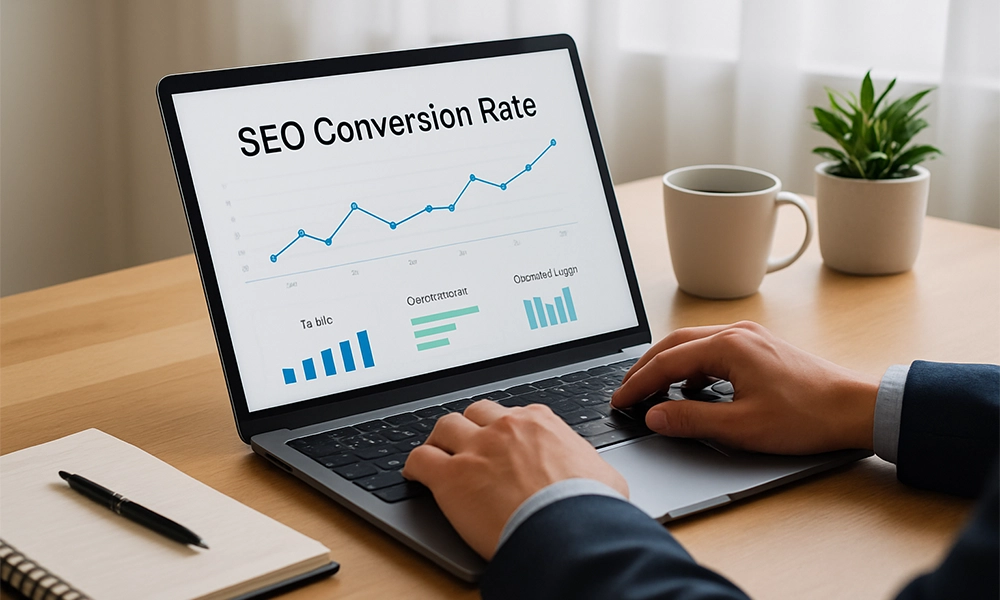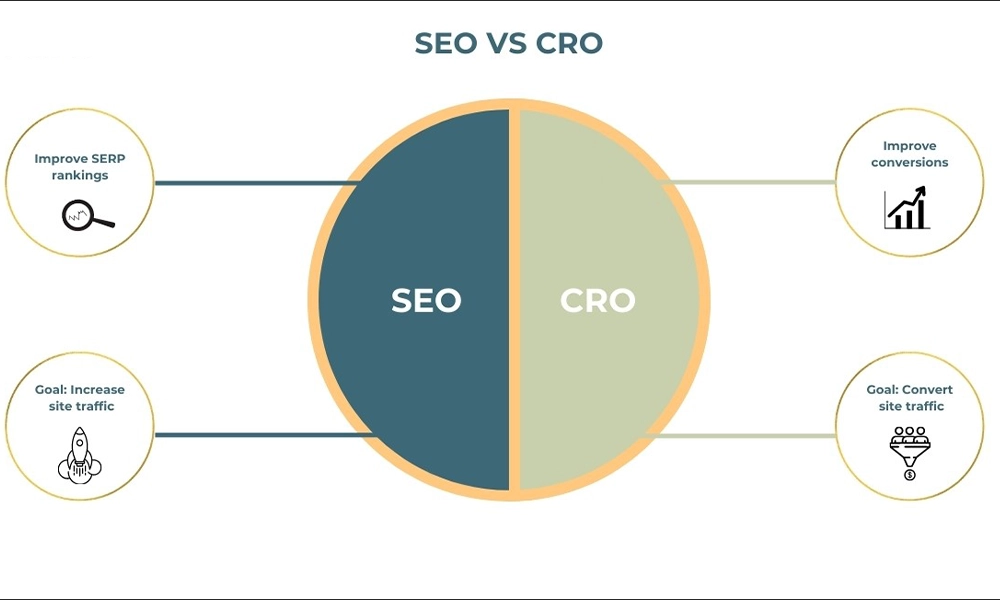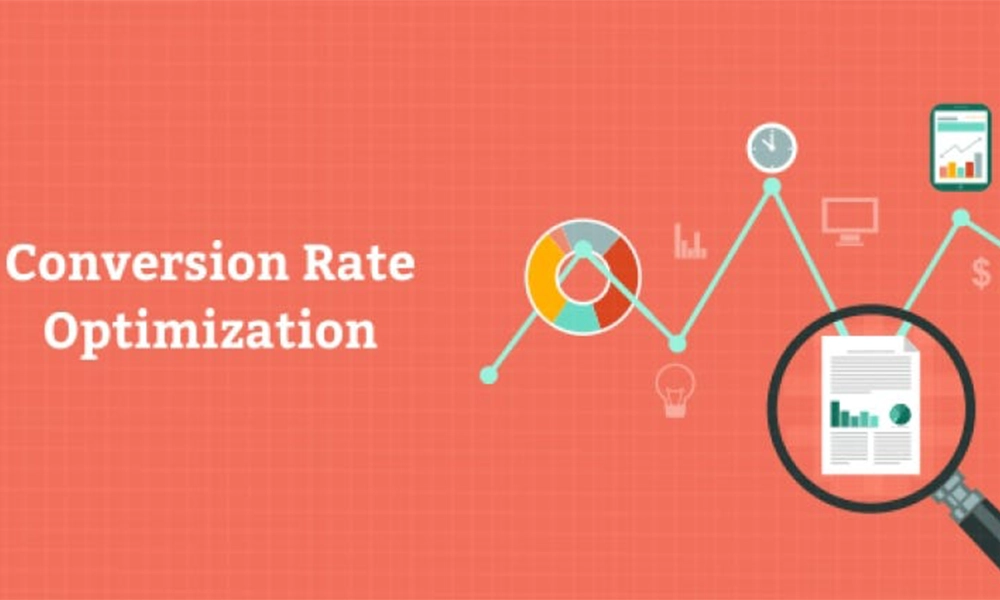What is a conversion rate in SEO?
The conversion rate in SEO refers to the percentage of visitors from organic search who complete a desired action on your website — such as filling out a form, making a purchase, or subscribing to a newsletter. It’s one of the most important performance metrics in any digital marketing strategy because it shows how effectively your organic traffic is turning into real business results.

Unlike general traffic numbers, the conversion rate focuses on quality over quantity. You might attract thousands of visitors through search engines, but if few of them convert, your SEO efforts aren’t truly successful. Factors like page relevance, site speed, mobile usability, and persuasive calls-to-action all influence how well your website converts organic visitors.
When you partner with professional SEO services, they don’t just aim to increase your website’s visibility — they focus on driving meaningful traffic that leads to higher conversions. A strong SEO strategy ensures your pages not only rank well but also guide users smoothly toward taking action, boosting both engagement and revenue.
Why SEO Traffic Converts Better Than Paid Traffic
SEO traffic tends to convert better than paid traffic because it’s driven by user intent. When people find your website organically, they’re actively searching for information, products, or solutions — meaning they already have a level of trust and interest. Paid traffic, on the other hand, often attracts visitors who click out of curiosity or impulse, not necessarily because they’re ready to buy.
Organic visitors usually spend more time engaging with content, exploring pages, and taking meaningful actions because they perceive organic results as more credible. SEO also builds long-term brand authority, which increases conversion potential over time — something paid ads can’t achieve once the budget stops.
With advancements like Generative Engine Optimization, the focus of SEO is shifting even more toward creating valuable, intent-driven content that aligns with how modern search engines — and AI-powered systems — understand user needs. This means well-optimized SEO traffic continues to outperform paid campaigns by delivering genuine, high-intent leads that are more likely to convert.
SEO vs CRO: How Optimization Impacts Conversions
When it comes to digital marketing success, SEO and CRO often work together but serve different goals. SEO (Search Engine Optimization) focuses on bringing the right audience to your website through better rankings, while CRO (Conversion Rate Optimization) focuses on turning that traffic into paying customers. The balance between the two defines how effectively your marketing funnel performs.

While SEO drives visibility and organic clicks, CRO ensures those visitors take meaningful actions — like signing up, purchasing, or requesting a quote. The true measure of SEO success isn’t just how many people visit your site, but how many of them convert. That’s where understanding your SEO conversion rate becomes crucial.
A high SEO conversion rate shows that your keywords, content, and landing pages are attracting the right users who are ready to take action. On the other hand, a high bounce rate with little engagement signals a disconnect between search intent and user experience. The best-performing brands continuously refine both SEO and CRO strategies — driving qualified traffic and converting it efficiently.
Optimizing for conversions doesn’t mean sacrificing visibility; instead, it means ensuring every click delivers business value. When SEO and CRO align, organic traffic turns into measurable growth and long-term profitability.
|
Factor |
SEO (Search Engine Optimization) |
CRO (Conversion Rate Optimization) |
|
Main Goal |
Drive qualified organic traffic |
Turn visitors into customers |
|
Key Metric |
Rankings, impressions, traffic |
Conversion rate, engagement |
|
Focus Area |
Keywords, backlinks, technical health |
Design, CTAs, user behavior |
|
Core Benefit |
Brand visibility and reach |
Improved ROI and sales performance |
The Role of Content Quality in SEO Conversion Rate
Content quality is one of the strongest factors influencing how well organic visitors convert. When your content is helpful, accurate, and engaging, users are more likely to trust your brand and take action — whether that means making a purchase, subscribing, or filling out a contact form.
Modern search algorithms evaluate not only keywords but also the meaning and relationships behind them. This is where Entity SEO plays a key role. By structuring your content around clear topics, entities, and user intent rather than just keyword repetition, you create relevance and authority in your niche.
High-quality content paired with smart optimization ensures users find exactly what they’re looking for. The result is higher engagement, stronger trust, and better conversion rates — the ultimate goal of every successful SEO strategy.
Technical SEO Factors That Influence Conversion
Technical SEO is often overlooked, but it directly affects how well your website converts organic visitors into customers. A site that loads slowly, has broken links, or isn’t mobile-friendly will frustrate users — causing them to leave before taking action. By addressing technical performance, you can create a smoother, faster, and more trustworthy user experience, which ultimately improves your SEO Conversion Rate.
When your site structure, page speed, and navigation work seamlessly, visitors are more likely to stay engaged and complete desired actions. Every technical improvement — from optimizing core web vitals to fixing crawl errors — helps build trust and reduces friction in the user journey, turning organic traffic into measurable business results.
The Best Ways to Track and Measure SEO Conversions Effectively
Tracking and measuring SEO conversions is essential to understanding how well your organic strategy drives real business results. It’s not enough to monitor rankings or traffic — you need to know which actions users take after visiting your site and how those actions contribute to revenue or leads.
Here are the most effective ways to measure SEO conversions:
- Set Up Goals in Google Analytics 4 (GA4): Track form submissions, purchases, or sign-ups to measure success.
- Use UTM Parameters: Identify which organic campaigns or landing pages generate the most valuable traffic.
- Monitor Behavior Flow: See how users move through your site before converting.
- Track Assisted Conversions: Understand how SEO supports conversions that happen later through other channels.
In modern strategies, Brand Mentions SEO also plays a key role in conversion tracking. When users see your brand mentioned across trusted sources, it builds credibility and encourages higher engagement and conversion rates. Combining analytics with brand visibility gives you a full picture of how SEO contributes to business growth.
Effective Methods to Track and Measure SEO Conversions
|
Method |
Description |
|
Purpose / Benefit |
|
Set Up Goals in GA4 |
Define and track key actions such as form submissions, purchases, or sign-ups. |
|
Measures how well SEO traffic turns into conversions. |
|
Use UTM Parameters |
Add tracking tags to URLs for organic campaigns and landing pages. |
|
Identifies which campaigns or pages generate high-value traffic. |
|
Monitor Behavior Flow |
Analyze how users navigate through your website before converting. |
|
Reveals user paths and helps improve on-page experience. |
|
Track Assisted Conversions |
Evaluate how organic traffic contributes to conversions from other channels. |
|
Provides a complete view of SEO’s role in multi-channel performance. |
|
Brand Mentions |
Observe mentions of your brand on trusted external sources. |
|
Builds credibility and boosts engagement and conversion potential. |
How to maximize SEO leads with conversion rate optimization (CRO)
To truly get the most from your SEO efforts, you need to focus not just on attracting visitors but on turning them into leads. This is where Conversion Rate Optimization (CRO) and SEO work hand in hand — refining user experience, improving messaging, and removing barriers that prevent users from taking action.
Here’s how to maximize SEO leads effectively:
- Optimize Landing Pages: Create clear, benefit-driven headlines and strong calls-to-action.
- Leverage User Intent: Align keywords and content with what your audience is actively searching for.
- A/B Test Elements: Experiment with forms, layouts, and CTAs to see what converts best.
- Simplify Navigation: Make it effortless for visitors to find key information and convert.
- Build Trust Signals: Use reviews, testimonials, and case studies to enhance credibility.
Looking ahead, the LLMO Strategy 2025 emphasizes integrating AI-driven insights, behavioral data, and automation to improve both search visibility and conversion performance. This forward-thinking approach helps businesses personalize experiences, predict user intent, and continuously optimize results — ensuring every organic visitor has a higher chance of becoming a loyal customer.
Measuring organic conversion rates in Google Analytics 4 (GA4)
Understanding how to measure SEO conversions in Google Analytics 4 (GA4) is key to tracking performance and optimizing your strategy. GA4 provides deeper insights into user behavior, allowing you to see not only how visitors arrive on your site but also how they engage and convert.
Here’s how to measure organic conversions effectively:
- Set Up Conversion Events: In GA4, mark key actions (form fills, purchases, downloads) as “conversions.”
- Filter by Organic Traffic: Go to Reports → Acquisition → Traffic Acquisition, then select “Organic Search” to isolate SEO-driven results.
- Analyze Conversion Paths: Use the “Path Exploration” feature to see how users navigate before converting.
- Compare Devices and Pages: Identify which landing pages and device types deliver the highest organic conversion rates.
- Use Predictive Metrics: GA4’s machine learning models can forecast potential conversions, helping you refine SEO strategies.
With GA4’s event-based tracking and AI-driven insights, you can make smarter decisions about where to focus your SEO and CRO efforts. By consistently analyzing this data, you’ll not only measure success accurately but also uncover new opportunities to increase organic conversions over time.
Conclusion
Successful SEO isn’t just about getting more visitors — it’s about turning those visitors into real results. When you focus on creating valuable content, improving website performance, and providing a seamless user experience, your site naturally attracts the right audience and encourages them to take action.
Understanding how users interact with your pages, tracking their behavior accurately, and continually optimizing based on data are the foundations of long-term success. The goal is to make every visit meaningful — guiding potential customers smoothly toward the next step and improving your overall SEO Conversion Rate.
At Quanta Agency, we help businesses go beyond rankings to achieve measurable outcomes through strategic SEO, content optimization, and data-driven decision-making. When visibility, trust, and usability work together, your website doesn’t just rank well — it delivers sustainable growth and long-term value for your brand.










